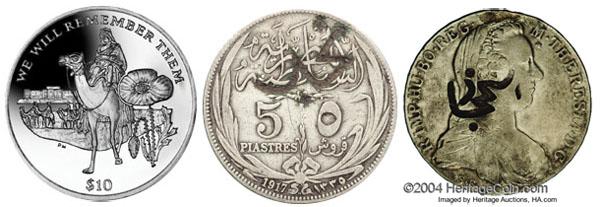Among the millions who participated in World War I, a few names live in history. The Red Baron is one. Lawrence of Arabia is another.
Britain’s Royal Mint’s latest coin sets commemorating people and events from WWI include gold and silver £5 coins honoring “Colonel” Thomas Edward Lawrence, better known as Lawrence of Arabia.
The common reverse design of both proofs by David Cornell shows Lawrence in his Arabian headdress. In the foreground are camels and riders representing the Arab revolt of 1916-1918 in which Lawrence played a significant part.
The silver coin comes struck on a 38.61 mm, 28.28 g .925 fine silver flan. The gold is on a 38.61 mm, 39.94 g .9167 fine flan. Both are edge-lettered: I WROTE MY WILL ACROSS THE SKY IN STARS, a quote from The Seven Pillars of Wisdom.
Previously, Lawrence has featured on several coin series featuring wartime heroes such as struck by British Virgin Islands and Tristan da Cunha.
And his time as a mainspring in the Arab revolt contributed to the many Ottoman and other coins that were counterstamped “al-Hejaz” and “Nejd” as the Arab forces came to occupy former Ottoman territories in the Hejaz.
Many myths surround Lawrence, a couple of which are perpetuated in the Royal Mint’s media release announcing the new coins. A somewhat more accurate précis is provided for those who get their history from Hollywood movie scripts.
At the outbreak of WWI, Lawrence was working as an archaeologist in the Middle East. He was fluent in Arabic and had many contacts among the Bedouin tribes, whom he admired immensely. He eventually volunteered for the British Army stationed in Egypt but was rejected as physically unsuitable. The British found him a niche in intelligence where they could use his extensive knowledge of the Hejaz (Arabia) and its people.
In 1916, he was sent to the Hejaz. Here he encountered the three sons of Sharif Hussein, Emir of Mecca, and concluded that the youngest, Faisal, would be the ideal leader for an Arab revolt against their Ottoman overlords. For his part, Faisal was impressed by the young Britisher who openly espoused visions for an independent pan-Arab nation.
The revolt had started in mid-1916 but had become bogged down as it lacked clear goals. Lawrence worked with Faisal to reposition his forces and coordinate attacks. Essentially, Lawrence’s strategy was that of guerilla warfare. The results came fast and were impressive. Ottoman forces around Medina were rendered powerless to attack Faisal’s positions given that the Ottoman railway south from Syria was constantly under attack.
Lawrence was assigned permanently to Faisal’s staff, where he not only liaised with the British forces but also participated personally in numerous attacks throughout 1917 and 1918. The Arabs named him Emir Dinimi [King Dynamite].
A 300-mile journey in June 1917 to Damascus saw him return with considerable intelligence and the cooperation of the local Arab nationalists. The British were sufficiently impressed to consider awarding him a Victoria Cross but settled for making him a Companion of the Order of the Bath.
He planned and executed the successful capture of Aqaba on the Red Sea on July 6, 1917, via a surprise overland attack. This result saw Gen. Allenby assure Lawrence of his total confidence, and from then forward, a free hand. His part in the rout of the Ottomans at the battle of Tafileh in 1918 saw him awarded the Distinguished Service Order.
Left: British Virgin Islands 38.60 mm, 28.28 g cupronickel $10 of 2014, KM-465.1, struck to commemorate Lawrence of Arabia. (Image courtesy Pobjoy Mint) Center: “Nejd” counterstamp on Egyptian 5 piastres AH 1327 Abd al-Aziz, KM-X1. (Image www.ha.com) Right: “al-Hejaz” counterstamp on frozen date Maria Theresa taler. (Image www.ha.com)
By the summer of 1918, the Ottomans had had enough of Lawrence. He and Faisal were tying down an inordinate number of their troops. They put a price on his head equivalent to $2 million today. No Arab betrayed him. For his part, Sharif Hussein treated Lawrence as one of his sons.
Although Lawrence was deeply involved in the buildup to the capture of Damascus, he was not present at the city’s formal surrender. He was beaten to the draw on Oct. 1, 1918, by the 10th Australian Light Horse Brigade.
Remarkably, throughout his war career, Lawrence was never formally commissioned. He carried various temporary ranks from Lieutenant to Lieutenant Colonel. Post-war Gen. Allenby even agreed to him becoming an informal full colonel for a few days to ensure he got a sleeping berth on the train from Tarranto to Paris during a peace conference. Unlike his temporary ranks, that of colonel was never gazetted.
For Lawrence, the temporary ranks were meaningless. He declined to be credited with them. He was well known as the scruffiest man in the British Army.
He also declined any of his decorations and awards. He returned his French Chevalier de la Légion d’honneur and Croix de Guerre with Palm and politely told King George V that he could not accept any British awards.
He was dismayed by the British government’s reneging on a promise of Arab independence and explained to the king it was his intention to fight the British establishment “by fair means or foul.” In the circumstances, awards would be inappropriate. The king accepted these views.
“We shall never see his like again,” Winston Churchill said.

